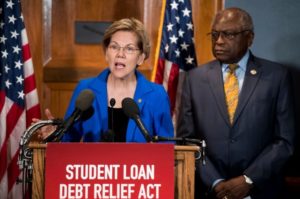As inflation rises to the highest level since 1982, Americans struggle to afford even the essentials. Student loan repayments will resume for millions in May – a crushing weight for many. Pleas for President Joe Biden to take executive action to wipe out student debt are growing, but neither his administration nor his allies in Congress seem too concerned about getting the job done. Biden campaigned on forgiving $10,000 per student, but many now ask for up to $50,000. Will the commander-in-chief deliver in 2022 – can he – or will he break yet another promise made to his voters?
Saving the ’22 Election

Elizabeth Warren and Jim Clyburn (Photo By Bill Clark/CQ Roll Call)
According to Sen. Elizabeth Warren (D-MA) and others on the far left, Biden could and should unilaterally wipe out $50,000 in student-loan debt for every federal borrower. Although he extended the pause on repayment due to the recent spike in COVID cases this winter, it does not seem to be nearly enough for his more progressive colleagues.
As we approach a critical election cycle, with the president’s approval seeming to plummet each week, Democrats have little choice but to do what they must to keep the voters happy, at least through the midterm. Broad-based student loan forgiveness could be that “magic ticket” that saves Biden’s dwindling public support as inflation rises and his party fails to pass significant legislation on the Hill.
The Debt Collective has warned the president that if he does not forgive up to $50,000 in federal student debt per borrower, he will lose progressive support and voters. According to recent polling data, no group has turned faster or louder on Biden than young voters. Millennials and Gen Zers are the strongest supporters of student debt forgiveness and make up many of those affected. Sen. Warren claims, “canceling student-loan debt for more than 40 million Americans would persuade a lot of young people that this president is in the fight for them.”
Turning up the Heat
The pause on student loan repayments started with President Trump and his Republican counterparts in Congress at the start of the pandemic. Biden’s most recent extension, running until May 1, will most likely be the last. This short-term move did little to squash out the numerous calls for more drastic executive action.
Representative Jamaal Bowman (D-NY) believes if Joe Biden “has the authority to pause student loan payments, he has the authority to cancel and ran on canceling at least $10,000.” He added that the party is “pushing him to completely cancel it, and that’s what we hope he decides to do.” Sen. Bernie Sanders (I-VT), Rep. Alexandria Ocasio-Cortez (D-NY), Rep. Cori Bush (D-MO), and Sen. Warren are all pushing for unilateral forgiveness and believe their party does not have a chance in November unless Biden takes immediate, aggressive action.
Why Not Cancel It?
 Despite what Rep. Bowman and many other lawmakers insist is possible, some argue President Biden does not possess the power to erase the debt entirely or even to forgive $50,000 each. Last April, the administration requested a memo from the Department of Education to determine his authority on the matter. A dept. spokesperson recently shared that it is still working with the White House to “review options with respect to debt cancellation.” It is unclear whether Biden has the memo and is sitting on it or if the DOE has failed to produce it.
Despite what Rep. Bowman and many other lawmakers insist is possible, some argue President Biden does not possess the power to erase the debt entirely or even to forgive $50,000 each. Last April, the administration requested a memo from the Department of Education to determine his authority on the matter. A dept. spokesperson recently shared that it is still working with the White House to “review options with respect to debt cancellation.” It is unclear whether Biden has the memo and is sitting on it or if the DOE has failed to produce it.
Senator Warren argues, “there is no legal obstacle.” As Presidents Obama and Trump each canceled debt for subgroups of people, she maintains Biden can do the same in executing total forgiveness. However, not everyone agrees the former Harvard Law professor’s argument is solid. Adam Looney, an economist at the University of Utah and former deputy assistant Treasury secretary in the Obama administration, warns that “the legal issues are actually much more complicated.”
To advocates, mass forgiveness is a no-brainer. Representative Jamaal Bowman says his fellow debt-ridden working and middle-class Americans “were preyed upon.” The former schoolteacher and principal shared that most people had no idea what they were getting themselves into, how hard it would be to repay their loans, and “how it all worked.”
Advocates close to the Biden administration claim the aggressive move has not been conducted for timing reasons, not legal concerns. According to one aide in the Democratic Party, the White House was preoccupied with passing the Build Back Better bill, and total student loan forgiveness is a “break glass in case of emergency” reservation. Suppose Biden’s plan continues to tumble down Capitol Hill and the Democrats start shaking in their boots as the midterms approach. Will the administration break that glass and take action?
~Read more from Keelin Ferris.




